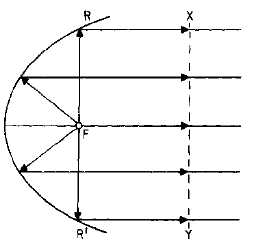3-5
REFLECTOR ANTENNAS
A spherical wavefront (one in which the energy spreads out in all directions) spreads out as it travels
away from the antenna and produces a pattern that is not very directional. A wavefront that exists in only
one plane does not spread because all of the wavefront moves forward in the same direction. For an
antenna to be highly directive, it must change the normally spherical wavefront into a plane wavefront.
Many highly directive microwave antennas produce a plane wavefront by using a reflector to focus the
radiated energy. The PARABOLIC REFLECTOR is most often used for high directivity.
Microwaves travel in straight lines as do light rays. They can also be focused and reflected just as
light rays can, as illustrated by the antenna shown in figure 3-2. A microwave source is placed at focal
point F. The field leaves this antenna as a spherical wavefront. As each part of the wavefront reaches the
reflecting surface, it is phase-shifted 180 degrees. Each part is then sent outward at an angle that results in
all parts of the field traveling in parallel paths. Because of the special shape of a parabolic surface, all
paths from F to the reflector and back to line XY are the same length. Therefore, when the parts of the
field are reflected from the parabolic surface, they travel to line XY in the same amount of time.
Figure 3-2.—Parabolic reflector radiation.
If a dipole is used as the source of transmission, energy will be radiated from the antenna into space
as well as toward the reflector. Energy which is not directed toward the paraboloid has a wide-beam
characteristic which will destroy the narrow pattern of the parabolic reflector. However, a
HEMISPHERICAL SHIELD (not shown) may be used to direct most of the radiation toward the
parabolic surface and thus prevent the destruction of the narrow pattern. Direct radiation into space is
eliminated, the beam is made sharper, and more power is concentrated in the beam. Without the shield,
some of the radiated field would leave the radiator directly. Since this part of the field that would leave
the radiator would not be reflected, it would not become a part of the main beam and could serve no
useful purpose.
In figure 3-3 the radiation pattern of a paraboloid reflector contains a major lobe and several minor
lobes. The major lobe is directed along the axis of revolution. Very narrow beams are possible with this
type of reflector. Figure 3-4 illustrates the basic paraboloid reflector.



